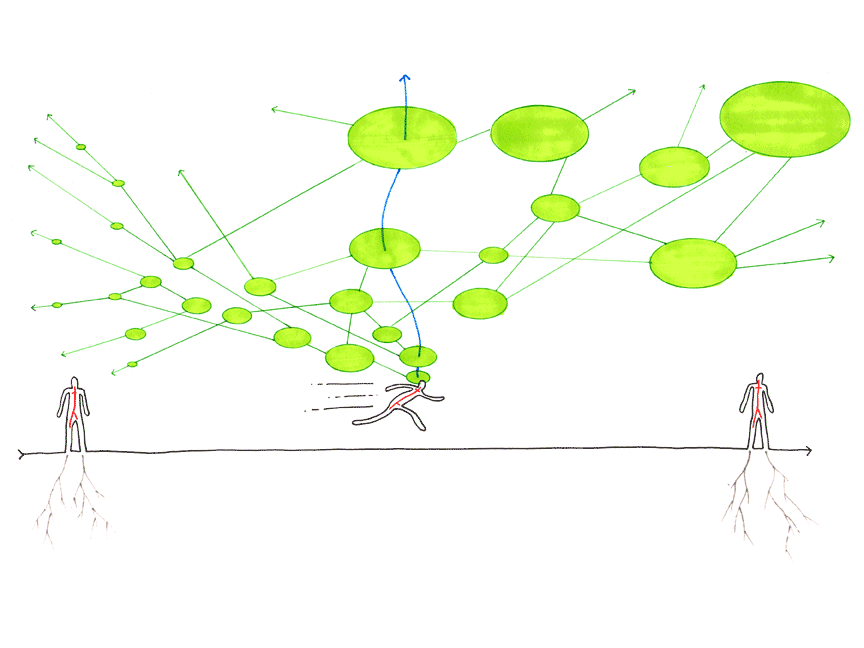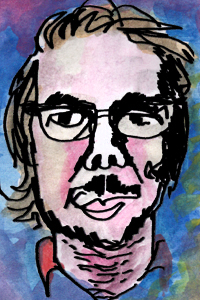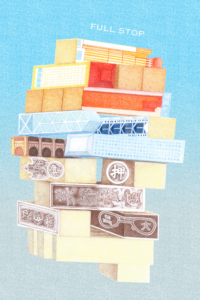
Illustration of paragraph 26 of the introduction to A Thousand Plateaus, by Marc Ngui. See more of Marc’s work here.
There have been two recent experiments in music distribution that the press has thought important enough to warrant vast swathes of comment. The first was U2’s terrifying collaboration with Apple to break into the iCloud accounts of every Apple customer and give them a copy of the band’s new album, presumably ironically titled, Songs of Innocence. So much has been written on this that there seems to be little more to add here. The second and more interesting was Radiohead front-man Thom Yorke’s release of his second solo LP Tomorrow’s Modern Boxes via BitTorrent.
This distribution method has been tried by artists in the past (see for example the free download of the Young Chronos EP by Gatekeepers via the Pirate Bay) but this is the first time it has been tried by an artist as large as Yorke and the first time it has been tried with a monetary exchange. Seven years after the release of Radiohead’s In Rainbows, which brought the pay-what-you-want model to the attention of the media, Yorke is once more trying to figure out how to get people to pay for the digital files that we call music these days — able to be infinitely copied at full quality and sent anywhere with an internet connection in an instant. Though for him this question could be seen as quite academic, and not a material imperative.
In the interest of full disclosure, I would say that I consider myself a fan of much of Yorke’s work with and without Radiohead. Indeed, I found Tomorrow’s Modern Boxes to be far more interesting than his most recent release, last year’s AMOK with supergroup Atoms for Peace. However, it is not an album in the sense laid down by Sgt Pepper’s — an era defining record that pushed the artistry of popular music — but rather it appears to have been conceived as a means of facilitating his experiment in distribution. To a certain degree this can be heard in the music, which at times is somewhat lack luster. However, such an approach to distribution, through the use of BitTorrent, warrants inclusion in a discussion of the music. This is not to argue that if we consider this release as a distribution experiment then the sonic experience is automatically enhanced. A mere text file could have illustrated the torrenting mechanism, and compared to that, Tomorrow’s Modern Boxes is sonically spectacular. Rather, a work entitled Tomorrow’s Modern Boxes, available only by BitTorrent, a wholly networked mode of distribution, must be considered in a way that understands the nature of the mode of communication through which it is accessed as a part of the artistic intent. That being the same mode of communication through which you are currently reading this text, which constitutes the fabric of day-to-day life for the majority of people in the post-industrial west: the internet.
At first as I downloaded a torrent client program onto my computer to facilitate my purchase of the album, I found the process to be something of a faddy chore. I had torrented before, but not since a recent hardware upgrade, so this feeling was not out of naiveté but rather in relation to the comparative ease of my recent purchases from various other virtual marketplaces. It seemed to me an odd and somewhat quaint way for an out-of-touch musician to rebel against the streaming paradigm now laid down by Spotify. However, when I took the time to read the letter posted by Yorke about the release I was reminded about what torrenting actually was and what that could mean. Specifically:
The torrent mechanism does not require any server uploading or hosting costs or ‘cloud’ malarkey.
It’s a self-contained embeddable shop front . . .
The network not only carries the traffic, it also hosts the file. The file is in the network.
The last line especially caught my attention and lead me to the conclusion that, in discussing this release, it is not enough to consider the insufficiency of the music or the gimmick of the delivery method. We must also explore the concept that “the file is in the network.” Tomorrow’s modern Boxes indeed.
* * *

Macon Holt is an academic cultural theorist, writer and musician. He writes a monthly column for Full Stop on pop music as a utopian political project.
The concept of the rhizome was notably developed by Gilles Deleuze and Felix Guattari in A Thousand Plateaus as the ontological foundation for the more constructive part of their Capitalism and Schizophrenia project. This idea allows for the conceptualization of reality as composed of non-hierarchical connections, free from the constraints of centralized monolithic power. This is the use of the term that I am referring to in the title of this piece. There is a tendency in the arts and humanities to use the rhizome as a conceptual deus ex machina (which, as it is itself a concept, can lead to much peculiar vagary), an inexplicable mystic good that stands up against various modes of oppression. However, this simultaneously gives the concept too much credit and sells it short.
We know for example, contrary to the liberatory sheen, that A Thousand Plateaus and its rhizomorphic approach have become a tool box for the IDF in their oppression of Palestinians. With their U.S. funding, the IDF is able to escape the perils of urban warfare by finding previously non-existing routes through the city, using ordinance to flatten walls and civilians alike. In addition to this, Luc Boltanski and Eve Chiapello argue in The New Spirit of Capitalism that by embracing the notion of a rhizomatic network, the managerial forces of capital have produced more insidious forms of oppression that have been key to the advance of neoliberalism over the last thirty years. My invocation of the concept is not to describe some panacea to the woes of distributing cultural production in the (post)digital age. Rather, considering torrenting through the rhizome can point to a change in thinking that needs to take place before anything can be done to address this problem of distribution. First however the term requires a more positive definition.
Put simply the rhizome is exemplified in the ginger root (an example of what is called a rhizome in the natural world), but to put it simply is inadequate. More accurately, the rhizome is the ways in which a ginger root differs from a tree. Deleuze and Guattari argue, starting from the disciplines of psychoanalysis and linguistics and ending up in ontology, that western thought is dominated by trees. Not in a beneficial ecological way but rather, in attempting to understand the complex phenomena of life, western civilization has often traced the outline of a hierarchical tree structures onto various phenomena that might not fit this structure. In tree shaped structures, branches connect not to each other but to a trunk core. This core itself is derived from similarly non-connected roots. They argue that this epistemological notion is dangerous in its reduction of the nature of what exists to that which fits in a tree-shaped trace. Such a tree-shaped trace is intrinsically hierarchical and as the tracers themselves are enmeshed in the hierarchies of late capitalism these are then reflected in the knowledge such trace-makers produce.
In response to this, D&G conceive the various phenomena that constitute societies and even existence as a rhizome. Main features of the rhizome (they outline six) include multifarious connectivity and a non-hierarchical structure. In the rhizome there are no points, only lines of connection and lines of flight. Lines that can rupture, reconnect or start anew somewhere else. It is an open system able to incorporate that which is external or incongruent with it. Against the hierarchical trace organization of trees, the rhizome is a map. It is a map that can be folded, represents no hierarchies, and is ever changing. One could argue that once one adopts this point of view on the phenomena of existence, the pettiness and insufficiency of capitalism appear in stark relief against the possibilities of desire and sociality.
* * *
The torrenting mechanism is not rhizomatic, it is made up of points and hierarchies, with each torrent swarm (the networked formation pertaining to the sharing of a particular file) as a closed system. However, as far as I can tell nothing that exists can entirely live up to the features D&G outline. Again, it is important to remember that the rhizome is not a benevolent force, as it is sometimes cast, but rather a beguiling conception of ontology. It does not stand up to oppression but allows for a conception of being that provides “lines of flight” that escape some of the limitations placed on it. In that respect it is useful to consider the torrent model as something that, through its capacity for decentralization, presents a line of flight away from the centralized conceptions of cultural production. This is decentralization in a more substantive sense than the admirable culture of amateurs on YouTube, for example, because it theoretically could prevent itself from becoming repurposed to serve the machinations of capital.
In being more rhizomorphic than traditional distribution models, torrenting is illustrative of alternative modes of networked communication, which are important not in their similarity to conceptual rhizomes but in how they differ from trees. In that motion, away from centralized, rigid, unidirectional structures (massive servers copying unwanted music onto your account), towards an open network composed of lines of flight, creates a differentiation: the capacity for an idea to be discernibly and irreducibly different from anything else. In such a difference there could well be the capacity to change. This is especially important now as the digital infrastructure of neoliberal capitalism, shown in the recent work of Maurizio Lazzarato, is used to limit diversity in the name of “the company spirit.” For all the rhetoric of radical innovation that can be found in late capitalism, the analysis of Deleuze and Guattari shows that capitalism actually requires tight restrictions to delineate and limit the possible. In this system what is claimed to be difference is often merely a refinement on the processes of the overriding logic of capital accumulation. Because the file exists in the network as opposed to industrial servers, torrenting is illustrative of modes of advanced mass communication that do not require the perpetuation of the power relations of the status quo, and as such highlights the inadequacy of such relations. Some may level at Yorke the charge of pseudo-innovation for profit, as the application of this model has allowed for significant downloads of a mediocre record. However, this profit seems to be more a result of the old fashioned creation of spectacle than the qualities of newfangled technology.
There is something odd in the jaded attitude with which many in the music press have received this distribution experiment, even when they reluctantly recognized the need for such change. But perhaps we can take something from this posture. The rhizomorphic lines of flight that we need to free us from the music industry’s structures will not be delivered from on high. Indeed, the notion that there are bands so important that how they get their music to you becomes a subject of comment in international publications is a result of restricted and hierarchical operations of culture. Only those artists that the marketplace of cultural production has in some way valorized are worth listening to and even then only within a particular paradigm. Treating Yorke as a messiah would simply perpetuate this state of affairs. Indeed, the torrenting mechanism itself is not without problems. With its propensity for the gathering of user data, listeners are left similarly reduced to being commodities of market research, as in more traditional models. This solution is, perhaps necessarily, incomplete.
That being said, what the release of this album has done, at least for me, is create a small rupture. It has produced an understanding of how popular music can exist as digital media without monolithic institutions, and how the popular, as a media form, can facilitate sharing music outside of purely monetary exchange. None of this is a rhizome; the rhizome is what we exist in all the time. Torrenting is simply one of many lines of flight, albeit one with the capacity for differentiation, a capacity essential to escaping the restrictions of trees. However, intrinsic to the importance of differentiation is that torrenting can only ever be one of the many lines of flight that will be needed to escape the tree structures that capital forces upon culture.
This post may contain affiliate links.






